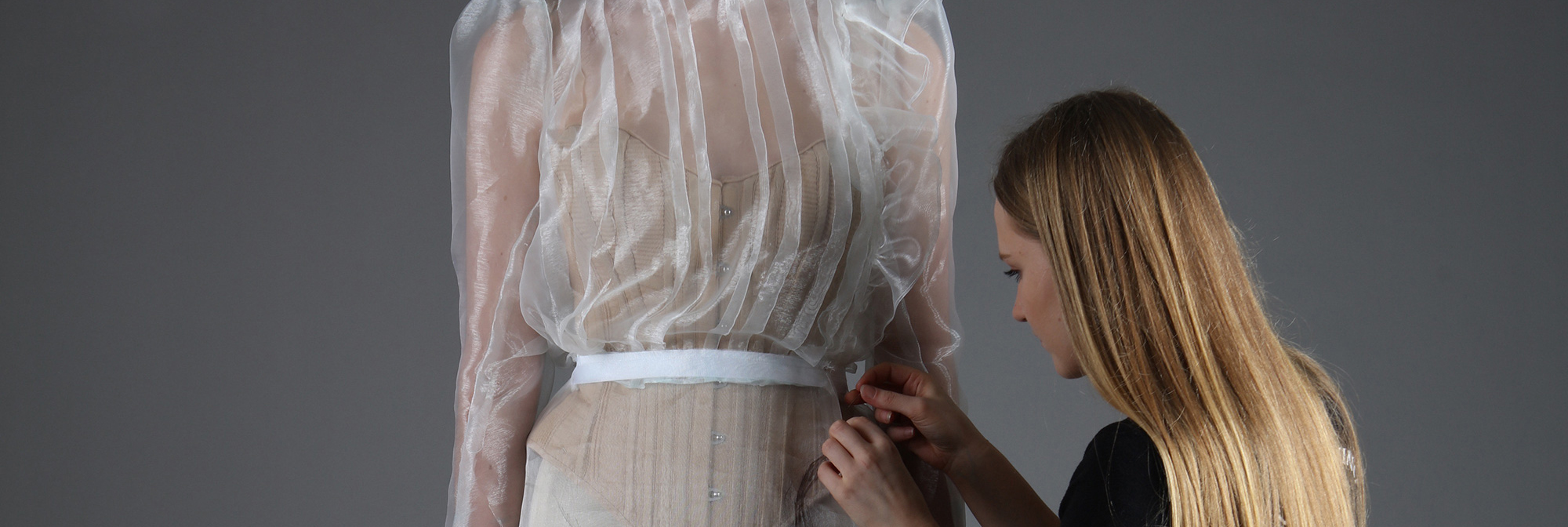This spring, while preparing for UAL’s online Graduate Showcase, BA Costume for Theatre and Screen graduate Evie Bertram found out she had won this year’s Costume Society’s Patterns for Performance Award for the work that would become her final piece.
We spoke to her to hear about winning the award, and the challenges and opportunities she encountered while working from home during Covid-19.
We also caught up with Course Leader Kevin Freeman to find out more about the Costume Society and how students can benefit from entering industry competitions.
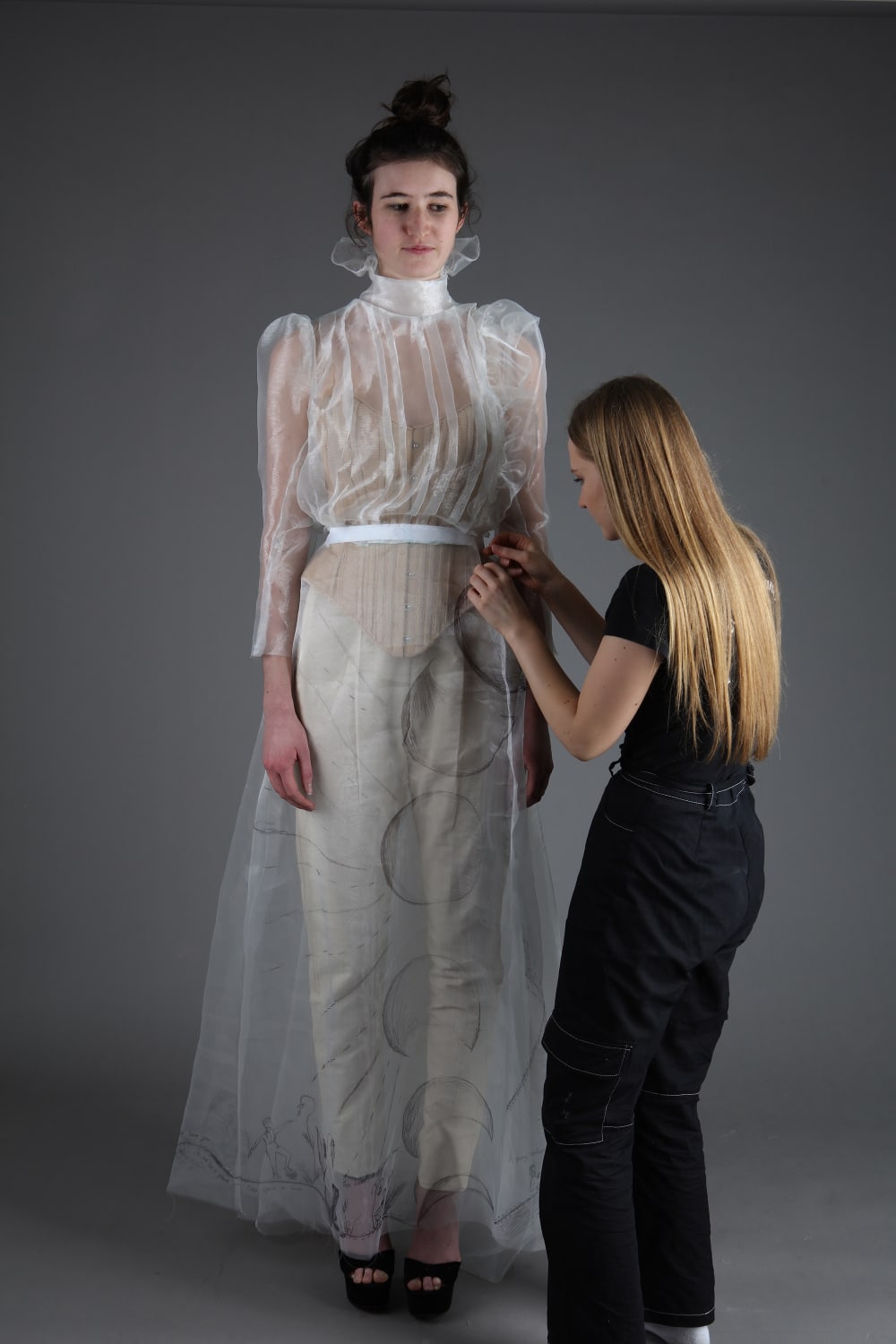
BA (Hons) Costume for Theatre and Screen, Wimbledon College of Arts, UAL | Photograph: Evie Bertram
Evie, can you tell us about the work you’re going to be showcasing in the online degree show?
Evie Bertram: I am showcasing two projects, a Theatrical Project and a Self-directed Project.
For my Theatrical Project, I chose a really interesting design from The House of Worth collection at the Victoria and Albert Museum (V&A). The design is commonly known as Checkers, Backgammon and Dice. It was made in Paris during the 1860s by Leon Sault, a designer, for Charles Fredrick Worth, a dressmaker. The checkers forms the overskirt and are also used to trim the borders of the skirt and bodice. Backgammon forms the apron and dice are used as trimmings throughout. The headdress features a dice shaker that falls to one side of the head.
I will present a series of photos from my workbook, documenting my process of recreating the costume. Unfortunately, I have been unable to finish the costume as I had to leave it behind when I returned home to Jersey during the peak of the pandemic.
For my self-directed project, I designed and made a costume for the character of the witch from the well-known musical Into the Woods. It is one of my favourite musicals as it entwines well-loved classic fairy tales together.
I view the character of the witch as a victim of other character’s crimes. I wanted the costume to reflect the dichotomy of her personality, making it eerie but romantic, just as she is depicted as wicked and selfish but also loving and misunderstood. To demonstrate this, I present pages of research from my workbook; including character and world boards, fitting images, process photos and final shoot pictures of the finished garment.
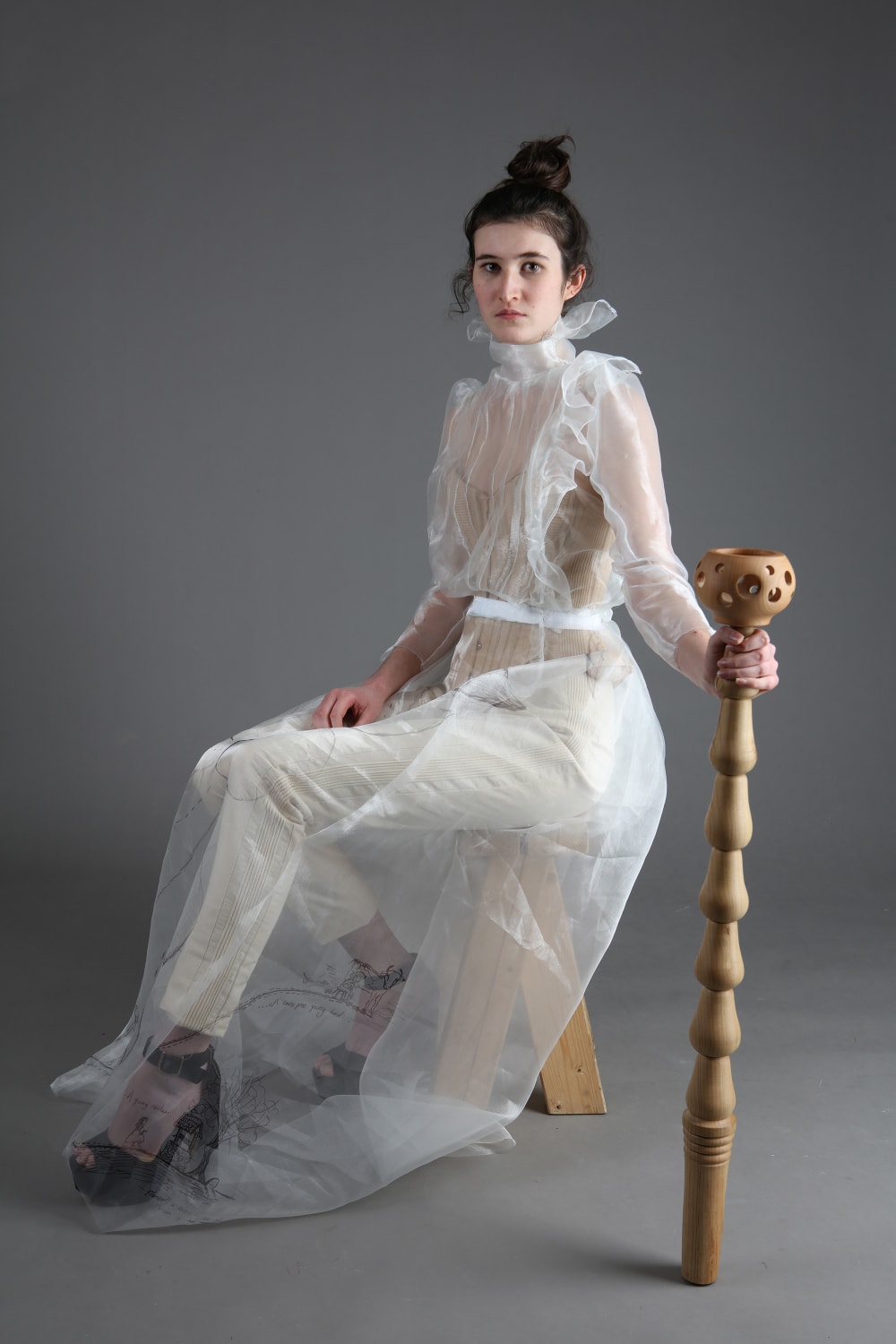
BA (Hons) Costume for Theatre and Screen, Wimbledon College of Arts, UAL | Photograph: Evie Bertram
Evie, can you tell us more about your design practice and the creative process involved in your work?
Looking at my Theatrical Project, it’s clear the design of this costume is extravagant. Before coronavirus, this costume was part of a dance/performance exhibit that was to be hosted by the V&A. Whilst putting together my initial ideas and the research I conducted into 1860’s fashion, it became apparent that a heavily boned corset would be unsuitable for a dancer to wear whilst performing as it would be too restrictive.
I therefore began collating images of undergarments from other eras settling on a 1950’s style. I made a crinoline to support the size of the skirt and created volume by making and layering net petticoats in a 50s’ tea dress style. I decided on red velvet for the bodice so it would feel expensive and luxurious like the design. I sampled different dye colours and decided the soft beige/mocha colour would work best against the black and the green.
I also used screen-printing in this project. As I disliked many of the fabrics I had sourced, I decided to print the checkers myself which also ensured I had the same number of checkers squares as the design.
I chose the Interpretation Pathway on my course, and as an interpretation student, I often neglect design practice, particularly drawing. However, for my Self-directed Project, by using a variety of mediums including water soluble graphite pencils and wax pastels, I created a set of designs I am happy with.
Into The Woods is based on a curse which occurs when magic beans are stolen from the Witch’s garden causing the Witch to become old and ugly. The curse is controlled by the moon which I used as a recurring motif. I made the dress using silk organza, showing a corset and trousers underneath dyed to match my model’s skin tone. This depicts the character’s strength and power, masking her vulnerability.
To create the illusion of the witch being a creature of magic, I redesigned a corset based on the 1890’s blue flossing corset pattern. It looks elegant, but it is heavily corded creating the wasp-waist synched style. I continued the cording down the side panels of the trousers to represent the bones of her skeleton. I chose dark grey and metallic silver threads for the majority of the embroidery as it mimicked the effect of the moonlight, however, I used accent colours to pinpoint important parts of the story. For example, the beans and anything magical are in gold.
I also used the technique of feathering which allowed me to attach feathers into fabric, creating realistic style birds but keeping them dainty and elegant. I made organza flowers to fill the back of the train, starting off beautiful and full of life but then appear to gradually decay as you reach the bottom of the train. To achieve this, I burnt some of the edges of the roses and sprayed some gold. I knew the organza would be difficult to work with so I decided a couture finish of French seaming would show off my skills for fine dressmaking.
I finished this costume off by woodturning a ‘magic’ tool. I used a range of different tools including a spindle roughing gouge, a shallow fluted gouge and a skew chisel to create the desired cuts and shapes. I used cherry wood for the bowl top and chestnut for the stem. Overall, I am so happy with how this costume came together.
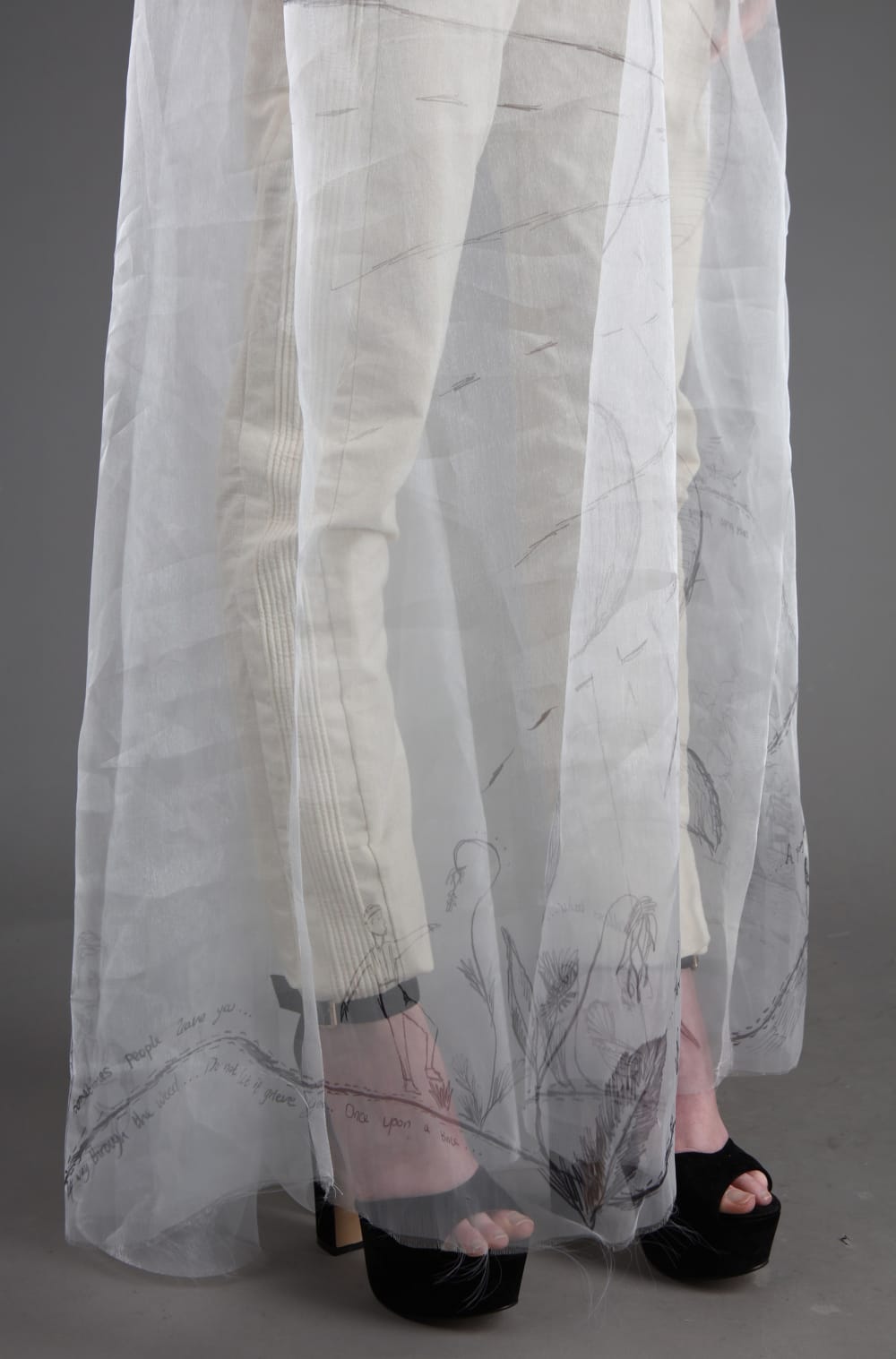
BA (Hons) Costume for Theatre and Screen, Wimbledon College of Arts, UAL | Photograph: Evie Bertram
Kevin, how does the course open up opportunities for students to engage in competitions such as those run by the Costume Society?
Kevin Freeman, Course Leader: The third year of study is very self-directed and students are required to write a Learning Agreement where they negotiate the shape and the output of their final year. In order to support this we offer a range of competitions, live projects and collaborations that the students can choose to undertake as part of their assessed studio practice.
These run alongside set projects but can often overlap. For example, Eleonora Pariselli, this year’s runner up for Patterns for Performance Award, chose to design Mozart’s The Magic Flute as one of her set texts. She combined this with The Costume Society entry by choosing to create a costume for The Queen of the Night that fitted in to both competition and course work. In the next academic year we will be offering both of the Costume Society competitions and also The Golden Shear’s competition, a tailoring award run by The Merchant Taylors Company, and an opportunity to design a cabaret gown for the performer Dolly Rocket.
Can you tell us a bit about the relationship and history you’ve established with the Costume Society Awards on the BA Costume for Theatre and Screen course?
Kevin: Last year, 2018/19, was the first time that The Costume Society offered the Patterns for Performance award and three of our students entered. One of whom, Clara Gelston, was the overall winner with Beatrice Darwell Taylor and Eve Oakley as runners-up. They attended the Costume Symposium and received their awards from Michelle Clapton (Game of Thrones).
The Patterns of Fashion award is very established and has been running for many years. It requires entrants to respond directly to historical patterns from the series of Janet Arnold ‘Patterns of Fashion’ books, and reproduce these exactly. This means using the same construction techniques, or as close as possible, as would have been used in the original garments. This is an excellent competition for some of our Interpretation students and Patterns for Performance has now opened this out to be inclusive for our Design students as well.
The Costume Society also included coverage of our collaboration with The National Gallery’s ‘Lorenzo Lotto’ project last year so our relationship with them is very good.
How were contestants from the course supported in creating their entries for the Costume Society competition this year?
Kevin: We are able to embed these competitions in to course delivery, which means that students are able to receive the usual Academic and Technical Support as they would in other projects. Nivera Gilbert, this year’s Highly Commended for the Patterns of Fashion award worked solidly for weeks in the studios on her handmade gown asking for support where she needed it.
Students are able to work on these competitions in the studios and utilise Wimbledon’s workshops if necessary. Although this element was rather stymied by lockdown for the Patterns of Performance students, where support was moved online. Our Patterns of Performance winner, Evie Bertram, signed up for regular tutorials with me, course tutors and technicians to run ideas past us and discuss progress and process throughout the construction process during lockdown.
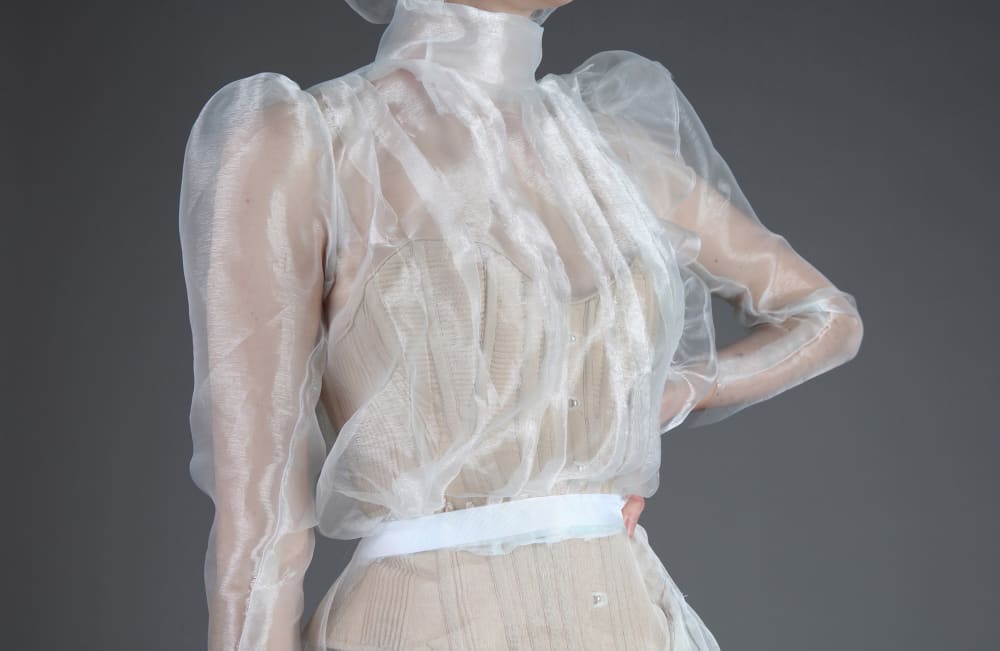
BA (Hons) Costume for Theatre and Screen, Wimbledon College of Arts, UAL | Photograph: Evie Bertram
How have you managed to set up a work/studio space since at home?
Evie: During the peak of the Coronavirus I decided to return home to Jersey (Channel Islands) to spend the time with my family. I actually found it really difficult in the initial stages knowing that I wasn’t going to be finishing the last term of my degree in the company of my friends who I had worked in close proximity with over the last three years.
I was, however, excited to get home to see my mother and my sister and work alongside them. I was, very kindly, allowed to transform our front room into a sewing studio where I could get my head down and focus. I am very lucky to have a shop mannequin and sewing machine at home which meant I could continue working at my usual pace with no interruptions.
Being at home with my family helped in keeping me calm and positive whilst I was working. I am so lucky to have such a wonderful and supportive family, particularly my mother and sister. I can’t thank them enough for their endless love and dedication to helping get me through the last few weeks of my degree.
Also, my tutors were so understanding and were more than happy to help me adjust my projects when I decided to return home. Initially I was very concerned that I wouldn’t be able to achieve everything I was hoping to, but very quickly they addressed my fears and put them at bay almost instantly. Their support and encouragement has been so valued, not just by me but by the whole of the student body. I am so grateful and cannot thank them enough.
Looking back on the last few weeks, having to finish my degree from home has been a blessing in disguise. It meant I had to be more creative in my approach to finishing my costume and creating surface designs and textures as I didn’t have Wimbledon’s workshops or facilities available to me.
Have these circumstances resulted in any unexpected opportunities, for example, a collaboration or a change in your usual practice and materials used?
Evie: Due to the current climate, I had to change or adapt part of my practice. I had never done tambour embroidery, so I had to teach myself the technique by watching online videos and tutorials and using books to support this. This initially proved difficult as I didn’t have a tutor there to correct me when I was doing it wrong, however I managed it and although it is one of the hardest techniques I have ever done, it looks beautiful.
Before the pandemic, I wanted to screen print the designs before I embroidered them as I thought it would look more professional, however, I didn’t have access to that kind of equipment while I was at home. I therefore decided to make stencils out of acetate and used silver metallic fabric paint to transfer the pattern. This was a blessing in disguise as the drawings had a childlike quality to them and the hand-printing retained this aesthetic.
The judging of the Patterns for Performance competition took place over a virtual call rather than as part of a conference in Birmingham. I felt extremely lucky to be able to speak with the judge and designer Michelle Clapton about my work for 15 minutes as she is well respected in the costume world.
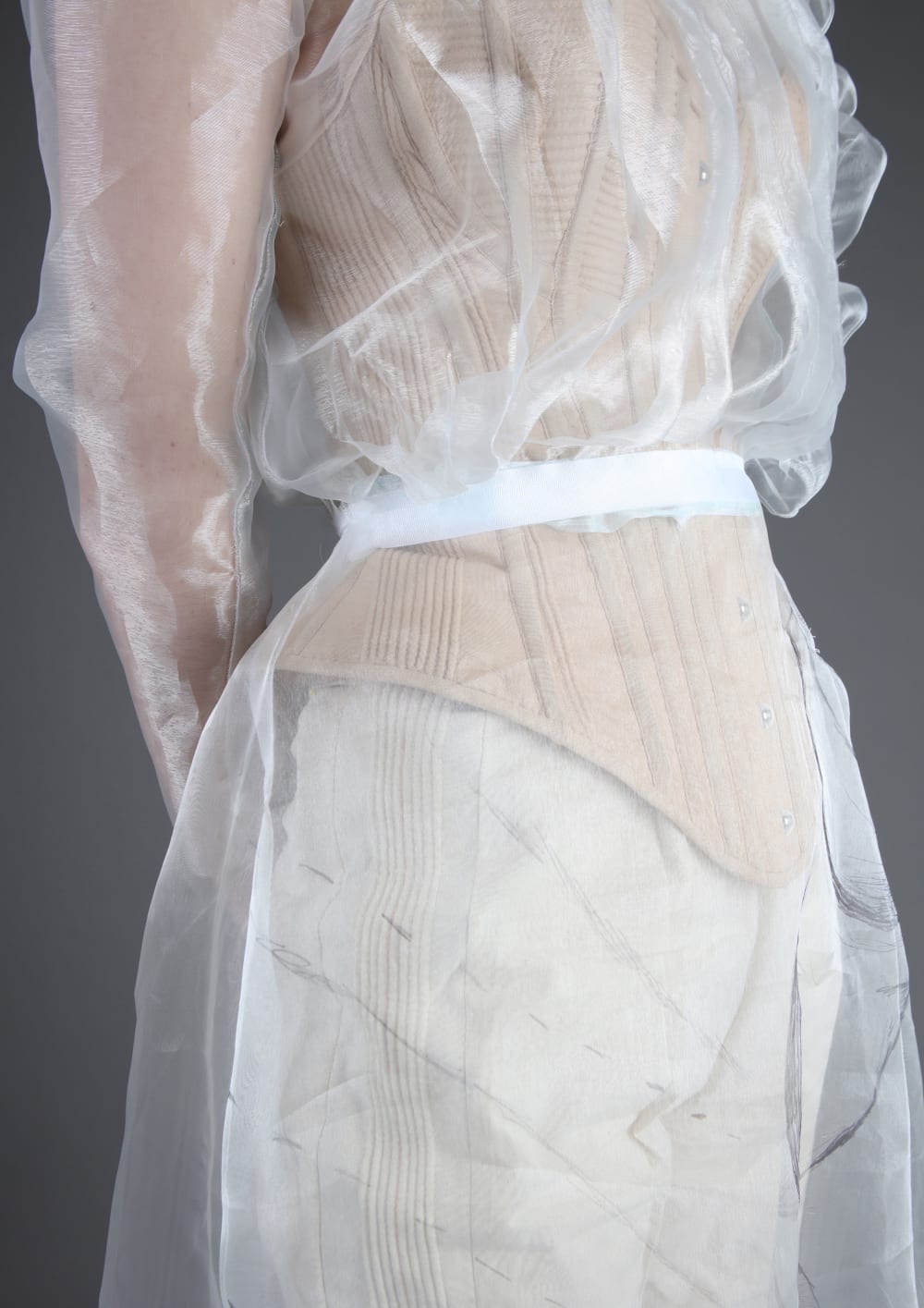
BA (Hons) Costume for Theatre and Screen, Wimbledon College of Arts, UAL | Photograph: Evie Bertram
How was your overall experience studying at Wimbledon College of Arts? And what was the highlight of your time there?
Being a student at Wimbledon College of Arts for the last three years has been one of the greatest experiences of my life thus far. It has helped me to achieve so much in such a short period of time. The close-knit community feeling is supported by excellent teaching which creates such a wonderful welcoming atmosphere. Whilst being a student at Wimbledon, I have made incredible friends, great contacts and worked on a well-known TV show.
I couldn’t pick just one highlight because there have been so many, but helping to organise and attending fundraising parties, modelling for other students, receiving constructive criticism and attending interesting lectures with industry professionals are just a few.
My greatest achievement so far is being the 2020 winner of the Patterns for Performance award which would not have happened if it wasn’t for the support and direction of my friends and tutors at Wimbledon.
Do you have any tips for students about to start your degree?
Before I came to Wimbledon, one of my sixth form teachers gave me a note that contained a quote that I took into uni with me every day: ‘The future belongs to those who believe in the beauty of their dreams’ – Eleanor Roosevelt. I set myself a goal, I dreamt what it would be like to achieve it, then I worked for it and I didn’t stop until I achieved it.
If I offer anyone any advice before starting your degree, it would be to never give up on what you want to achieve. If at any point you’re concerned or worried, confide in your tutors, family and friends. They offer so much support for even the smallest of concerns. There are bound to be setbacks along the way, there were for me, but it’s how you work and get through them that is important. Take every opportunity that is offered to you, work hard and don’t forget to enjoy your time at university.
And one final question for Course Leader, Kevin: What are the benefits gained from students partaking in competitions while studying on their course?
The benefits are endless. The most obvious would be exposure. It allows students to have their work seen on external social media channels and shared in a variety of ways that promotes them and their work, which then in turn adds value to their CVs. I know all the students who entered The Costume Society Awards enjoyed the opportunity to talk to Michelle Clapton about their work and felt very positive that she was then aware of them and their abilities.
Live Projects mean that students get to work with directors, choreographers, and performers so that their experience becomes ‘real’. They will then have experienced how a performer moves, how costumes light, the requirements of quick changes and dialogue with a production team on creating costume for live performance.
Engagement with external institutions such as The National Gallery and the V&A also allows work to be photographed and showcased in some of our most dramatic and respected institutions, which in turn adds value to students’ portfolios. Not to mention the fact that it is really exciting to see their work in these settings. Some competitions offer cash prizes which is always appreciated when on a student budget!
The Wimbledon College of Arts Graduate Showcase is now live, offering a first look at the most exciting new names in art and performance design.
Find out more about BA Costume for Theatre and Screen
Follow Evie Bertram on Instagram: @evangelinerosedesigns
